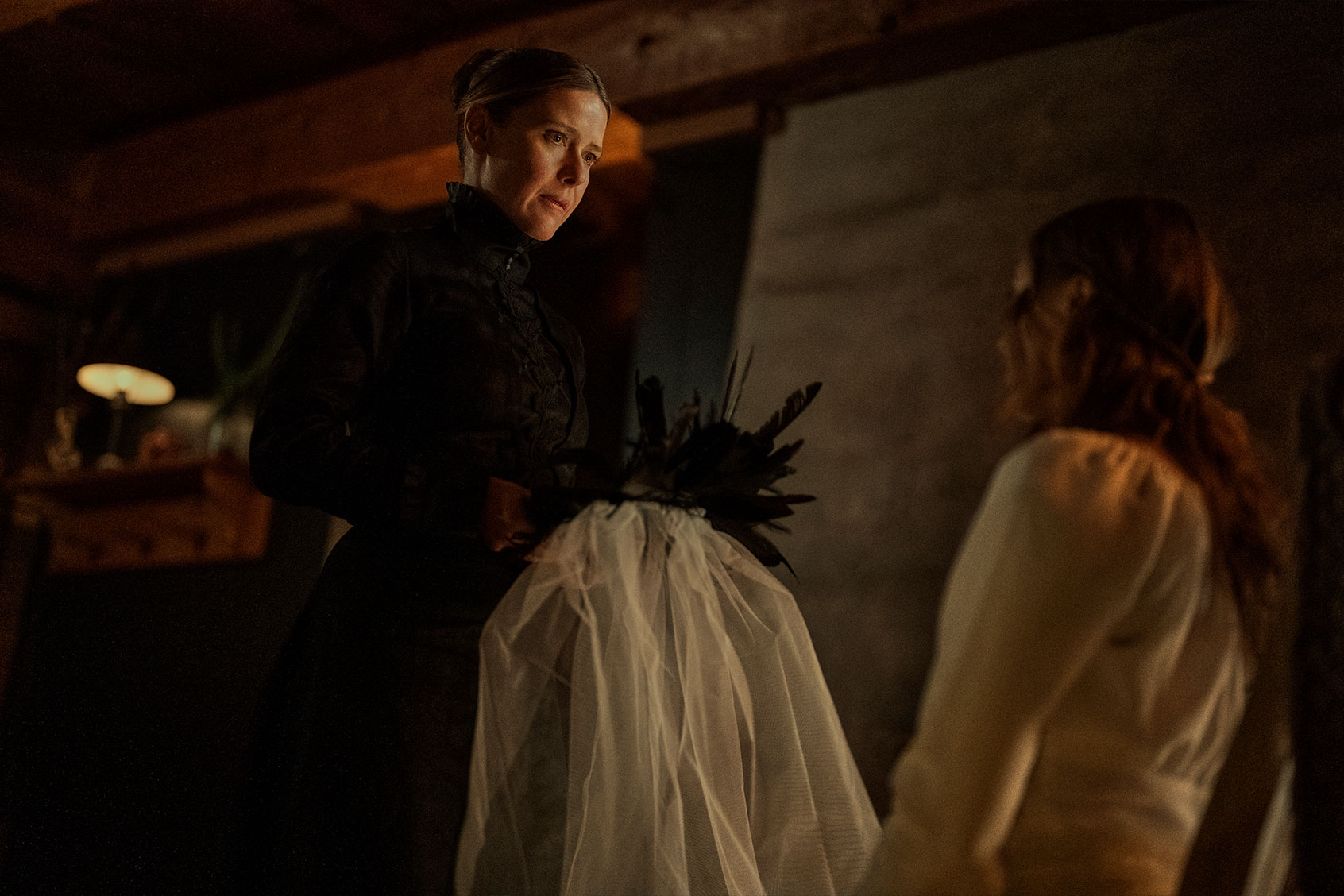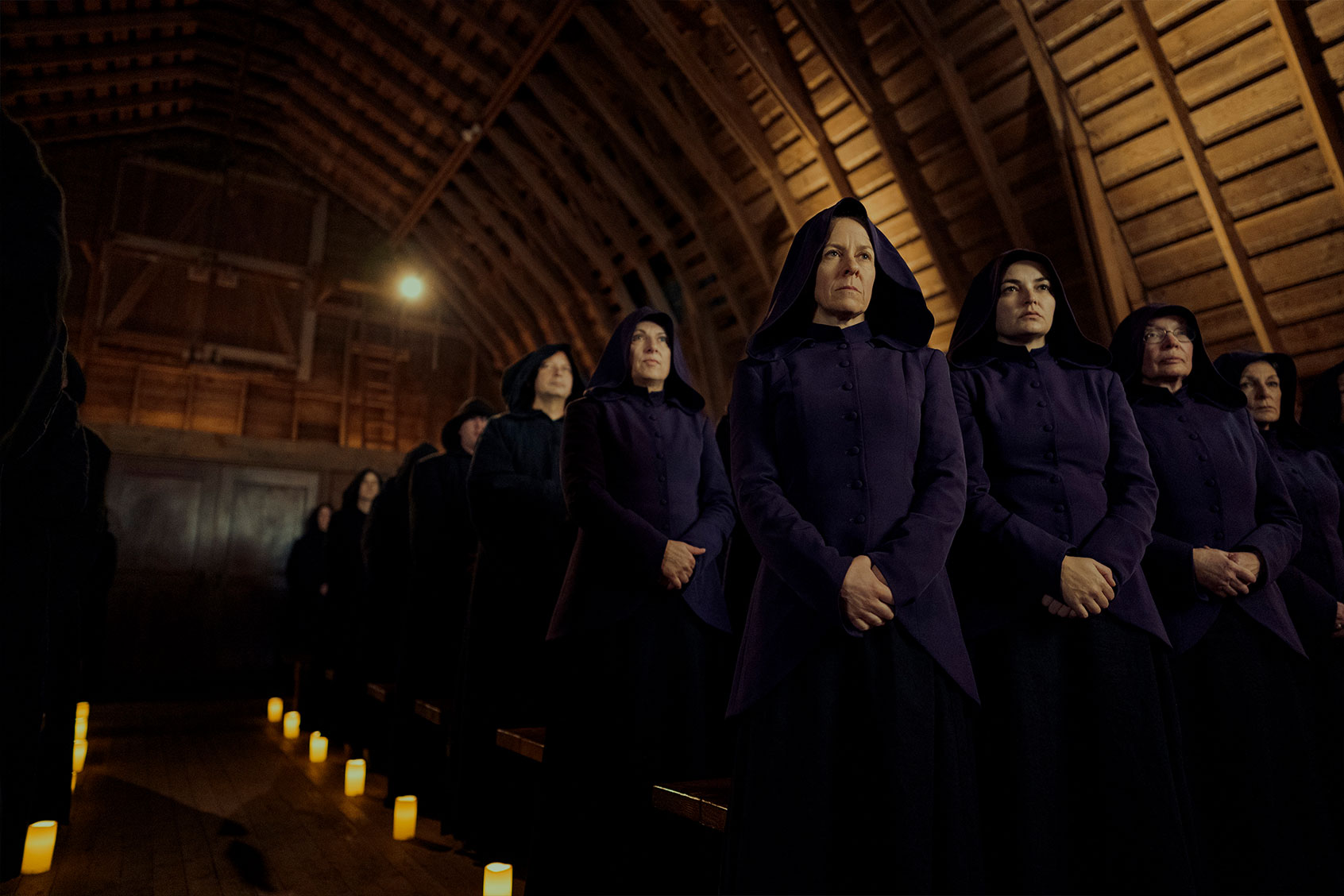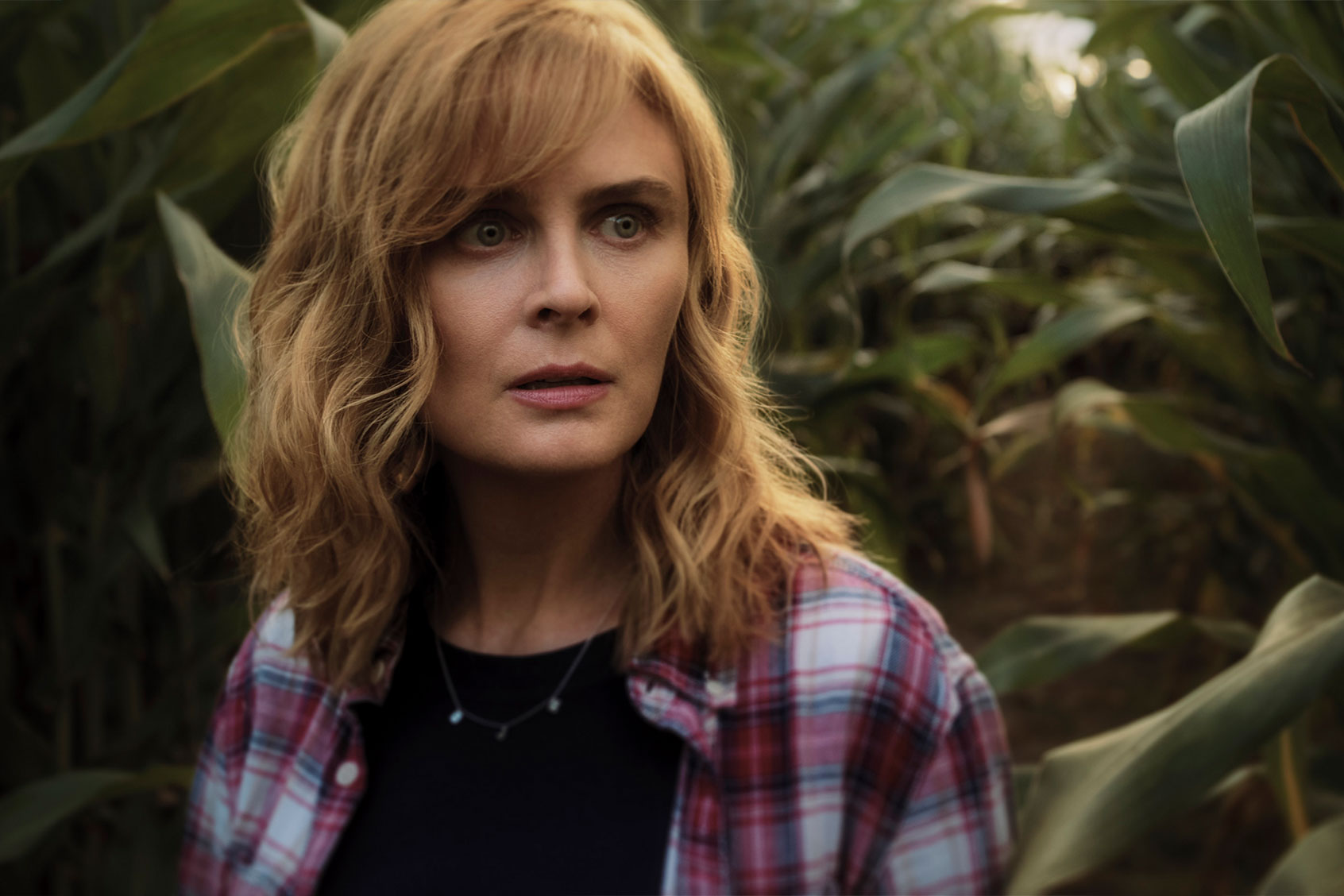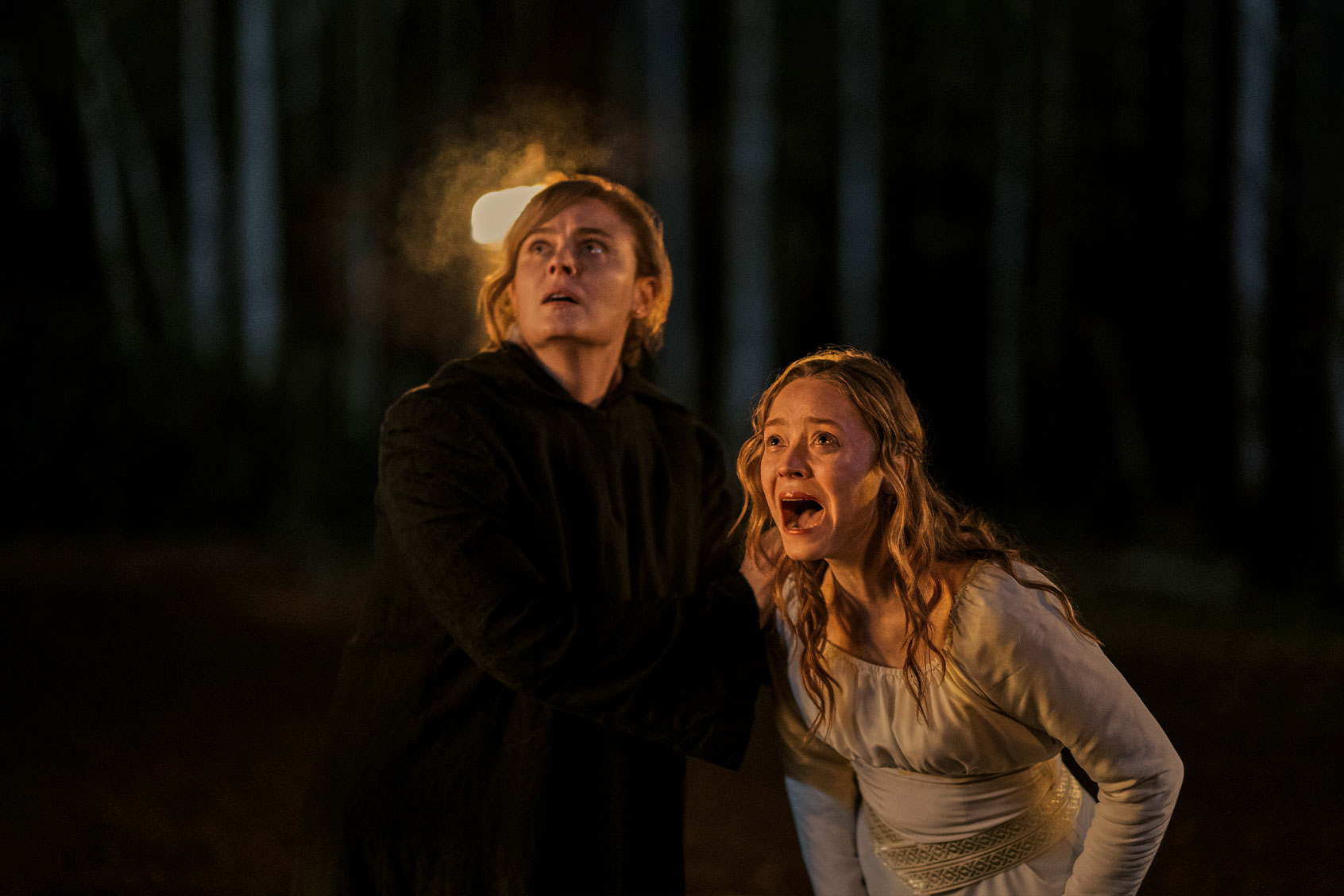Netflix’s “The Devil in Ohio” has the distinction of being the first show that I know for certain both my partner’s mother, grandmother and I watched. The age-defying appeal makes sense as “The Devil in Ohio” is a story of generations, as much the tale of Suzanne (the always compelling Emily Deschanel), a middle-aged therapist, wife and mother of three, as it is the story of Mae (a luminous Madeleine Arthur) a teen girl who ends up in the emergency room with a terrible wound cut into her back and a secret she won’t tell, at least not right away.
It joins a bumper crop of Netflix shows that seem to be responding to our need for shorter stories, after a plethora of lengthy movies. The limited series is only eight episodes long, yet still manages to be a ride. Mae has escaped from a strict and cloistered cult in rural Ohio, and despite Suzanne’s acceptance of her into her own home, the girl has trouble adjusting (understandably, as do Suzanne’s daughters). Mae’s first meal with Suzanne’s family? She prays earnestly to Satan.
While Suzanne’s determined to keep Mae from falling back into the clutches of the cult members who mean to burn her as a sacrifice, Suzanne’s own family one by one begins to resent Mae for what they perceive to be her underhanded narcissism. Chief among those is middle daughter Jules (Xaria Dotson), who is Mae’s age and eventually feels supplanted by her. Not only does Mae somehow become popular at school, a feat Jules has never achieved, but Mae also attracts Jules’ crush on the school newspaper.
Mae is a complex, shifting character, difficult to read, to know her intentions — or if she’s simply falling back upon what she knows. This complexity is crystalized in the end of the series. Time has passed. Mae seems to have settled into a life with Suzanne (completely disrupting Suzanne’s family in the process), then Suzanne learns from a cop investigating the case that Mae went back to her cult family willingly, requiring Suzanne to “save” her. The last shot of the series is a dazzling image of an altar Mae has set up secretly in the woods with candles, roses, ribbons, offerings and an image of herself and Suzanne. To pray for what she wants, to the god she knows.
Daria Polatin adapted the series based on her novel of the same name. Salon talked with Polatin about Mae, reinventing the Satanic cult and that shocking ending.
This interview has been edited for length and clarity.
What was the process of turning your book into this Netflix series?
Really exciting. And you know, a book is very interior. This was mostly told through Jules, her point of view. We’re really inside her head. And the horror kind of comes from that, Mae coming into her family and starting to displace her and gain her mother’s interest. It was really fun to tell the story through that lens.
I’ve been working on this story for eight years since we started the book. And so, moving into series I was really interested in: well, why does Suzanne take Mae home? Because that’s sort of the crux of the story, right? She brings in the outsider into the home.
“The monster is the gap in our own psychology, the gap between who we are and who we think we are.”
I was really interested in the series as more of a psychological study of Suzanne. What happened to her that made her do that? How far is she going to go to protect [Mae]? For me that became a really exciting thing about this series, to get to tell that story through her point of view, and have an incredible actress like Emily Deschanel play that role and give it so much life and depth and complexity. Then it was really fun also to open up some of the other storylines, to do the Detective Lopez [Gerardo Celasco] storyline, the kind of investigation part which we didn’t have the room for in the book. To get into Peter’s [Sam Jaeger] storyline, Suzanne’s husband, and see how it was affecting their marriage.
In the first episode, you see these little cracks between the characters, and then Mae comes in and makes those cracks chasms. She’s the catalyst for unearthing all this stuff that’s been there and destabilizing the family. We get to just watch them fall, watch the car crash, watch the crumble. It speaks to the fragility of relationships and groups and families . . . We’re all always wondering, is [Mae] a force for good? Is she a force for evil? Is she actually intentionally doing something to upset Jules or someone else?
Or is she just a victim and a survivor looking for a safe place? We ask that question of her up until the very last moments of the show. So, she was a very intriguing character.
 Caroline Cave as Abigail Dodd and Madeleine Arthur as Mae Dodd in “Devil in Ohio” (Ricardo Hubbs/Netflix)
Caroline Cave as Abigail Dodd and Madeleine Arthur as Mae Dodd in “Devil in Ohio” (Ricardo Hubbs/Netflix)
This really is a story of different women from different generations, Suzanne and Mae and Jules and also Mae’s mom. How did you decide to make it about the stories of all these women?
That’s what interests me as a writer and from my own background. I grew up with a mostly single mother and a sister, and I was always very interested in why my mom was the way she was, and then how that made me feel and react. Now I have a son, and how is the way I behave affecting him? The psychology is really interesting to me.
Can you ever change the trauma? Can you ever outrun the trauma of your past is one of the big questions of this show, and, you know, Suzanne is in therapy; she says, “I’ve dealt with it. I’m good, I get it.” But then Mae’s presence unlocks this piece of her psyche that she hadn’t dealt with . . . It’s like what Dr. Daniels says, from Carl Jung, “Until you make the unconscious conscious, it will direct your life and you will call it fate.”
The monster is not some vampire or ghost or werewolf. The monster is the gap in our own psychology, the gap between who we are and who we think we are.
What first inspired this story?
I think what has always interested me is the dynamics of micro communities and small groups. And what makes something just fitting into a group and what are the lines between that and a cult? If you have to wear your hair a certain way to fit in with a social group at school or dress a certain way or adopt certain beliefs in your in your family to fit in, to not have an argument at the dinner table, where are the lines between taking certain steps to fit in and then giving up your own ideas to buy into the group ideology? That gray line is very interesting to me. I had written this pilot, kind of about those ideas. And then our executive producer, Rachel Miller, came to me and she said, “I heard this true story of this girl who escaped from a Satanic cult, and the psychiatrist’s family took her in,” and I was like, “Oh my God. I have to tell that story.” I was just hooked from the beginning. We took the seeds of the story, the building blocks, and then built out from there and fictionalized it.
It’s interesting that it’s a Satanic cult because I went into it not knowing anything. You might assume something from Mae’s more modest, conservative dress, but we discover at the end of the first episode, she’s praying to Lucifer, which is quite a moment.
“You hear ‘Satanic cult,’ and you think, goat’s head and blood and pentagram on the floor and candles. I wanted to reinvent what that might look like.”
Apparently that’s very big on TikTok. People are obsessed. It’s really funny. Well, what’s normal for one person is completely abnormal for somebody else . . . It just came to me when I was writing the pilot. We don’t spend a lot of time with the cult. We only have the screentime that we have. How do you show who Mae is through the way that she acts and interacts with people? . . . It was about how to give clues about where she’s from, and what her background is through these moments of behavior, action, and speech and what feels completely normal for her.
Creeping around the house and leaving a corn husk doll by Jules in her bed or going into her room in the night. You then see when you go to her flashback, [Mae] sleeps in a room with many other girls, and her brother shows up at the foot of her bed . . . It’s what she’s used to. She doesn’t eat at the beginning of Episode 2. She’s sitting in her room waiting until the doors open.
 Heather Feeney as Purple-Robed Nun in “Devil in Ohio” (Ricardo Hubbs/Netflix)
Heather Feeney as Purple-Robed Nun in “Devil in Ohio” (Ricardo Hubbs/Netflix)
How did you create the cult? The specifics, especially the wings and the black birds, the masks and the black feather crown, how did you come up with these elements of a cult?
My writers’ room and I did a lot of research. We looked at a lot of different cults, communities, religious groups. We interviewed people. We read books. We watched documentaries. We absorbed as much as we could. And I really wanted to create something that we hadn’t seen before. I think you hear “Satanic cult,” and you think, goat’s head and blood and pentagram on the floor and candles. I wanted to reinvent what that might look like, and make it really specific and give them a backstory as to how they got to be the way that they are.
They are locked in time. They became very insular, almost 100 years ago. It’s a breakaway cult. They’re not looking for new members. They’re just looking to stay isolated . . . You’ve seen a crow or raven as an omen, but what if we take that further? What if we take that to be an important visual image for them? Caleb Dodd heard a message from a crow. So, was it a vision? Was it a psychotic break? Lots of religions are started over visions. And then, so taking the seed of that, and building on that, and the crow becomes a very sacred image to them, that they lean into.
Another element that’s striking about the show is the music. Can you talk about the music, such as the theme song? How did those songs come to be?
We hired the most brilliant composer Will Bates, who has been such a huge, creative, artistic contributor to this show. We worked very closely with him to find the right sound. There are a lot of old fashioned instruments he’s using to create that authentic feel of that sort of locked in time. He started earlier than composers usually start — usually, once you have your rough cuts of the edits. But he came on early because we were filming the scene in the church with the hymn and we needed people to sing on camera.
He and I sat down and I gave him all our cult imagery and language: the dawning, the Morningstar, the sacrifice, the pain. He took that and created this gorgeous hymn, which we then play from the beginning where you don’t know; it could be just a church song. It’s a bit of a misdirect.
He did an incredible job finding the sound for everybody … Then we brought in Bishop Briggs who’s got such an incredible emotional strength and vulnerability to her voice and her music. We went to her for our title music and she and Will worked together to compose the song “Lessons of the Fire,” which we absolutely loved. We also brought Isabella Summers from Florence and the Machine who did a song. In the last episode, we have a few pieces of it playing throughout, but it also plays at the very end.
It’s about finding these collaborators who had that sort of visceral raw emotion and beauty to their work . . . We’re very excited that [the music is] out there and can stand on its own as well, in addition to being part of the show,
A big part of the story is Mae. It’s not totally clear what her intentions are, maybe until the very end. Maybe not even then. Why was that important to you to have that kind of ambiguity?
That’s what’s interesting about her. Is she an innocent victim or a manipulative perpetrator? It depends on what perspective you look at it through. In working on the character with Madeleine Arthur, who does an incredible job with this role, she has so much going on, but you also can’t fully tell what she’s thinking. She’s so enigmatic. She’s just completely nailed this role.
The way we approached it is that she’s looking for safety. She’s looking to make a place for herself. She’s looking for a home. She’s looking for people to love her and take care of her. And those are very basic human instincts. We never approached it from a nefarious place. Because most people think they’re doing the right thing. Even if they are doing things that end up hurting other people. They don’t think they’re being evil humans, for the most part.
 Emily Deschanel as Suzanne Mathis in “Devil in Ohio” (Courtesy of Netflix)
Emily Deschanel as Suzanne Mathis in “Devil in Ohio” (Courtesy of Netflix)
What was so interesting to me about her character is to always be asking that question about her. On one hand, Suzanne has loved her and sheltered her and is taking care of her, and she wants to stay with Suzanne. She’s a young woman who wants a home. On the other hand, again, it’s about outrunning your past. She’s the daughter of a manipulative cult leader. She’s grown up with these dynamics. So she doesn’t know that they’re maybe not the best way to go about things in the outside world. But that’s what she knows.
At the end, it doesn’t even necessarily mean she’s evil. This is how she knows to continue to maintain safety in the bounds of her world. To just do what she’s always done.
If you were to have a second season, what would you accomplish with it? Do you think there’s more of the story to tell?
We looked at this as a limited series with a beginning, middle and end. We put all our cards on the table. We threw it all out there. But naturally, the story does have some questions. Where did the cult go? What are they doing? What is Suzanne gonna do in the next moment? Is she going to pick up the phone and call Peter?
Is Suzanne’s family going come back together?
It organically has these questions built into it. I do think that there is a kind of ending for Suzanne, because I think we see in that last moment on her face, the shoe fully drops for her. She realizes what Mae has done. And we tee it up in that conversation with Dr. Daniels, where Suzanne, says, “I’m working on myself. I’m working through these things.” Then Dr. Daniel says, “Do you think everyone’s capable of change, if they put the work in?” And Suzanne says, “Well, if I can do it, so can Mae.”
So the answer to the question: Can you outrun or change the trauma of your past? It has one answer for Mae. And one answer for Suzanne.
Want a daily wrap-up of all the news and commentary Salon has to offer? Subscribe to our morning newsletter, Crash Course.
Suzanne does to me, finally, fully realize that even though she’s able to change her behavior, Mae might not be able to. I’ve imagined all sorts of different permutations of this show and where it goes, and these relationships. So I think there is a world where story could continue. And there’s also a world where it can just be what it is. A conversation piece and something for people to talk about and wonder about.

